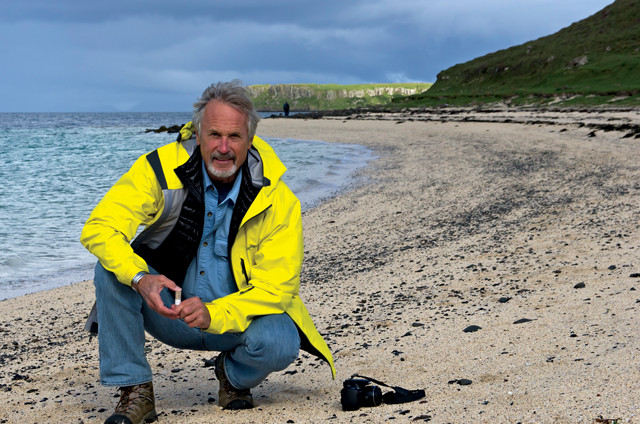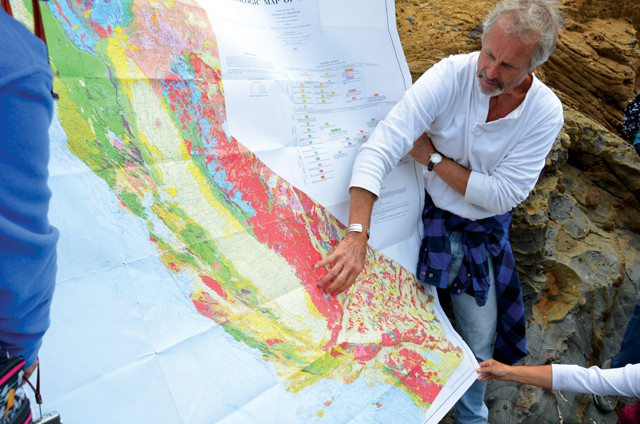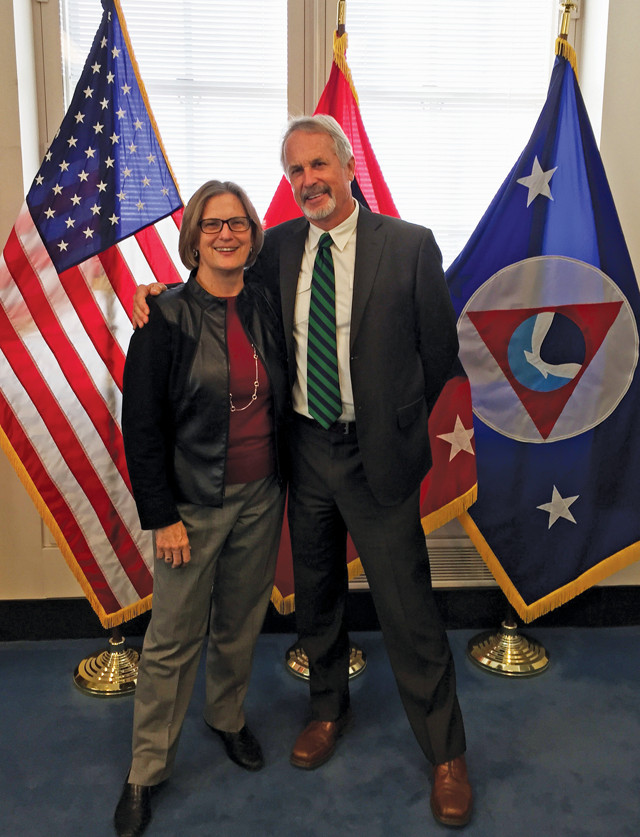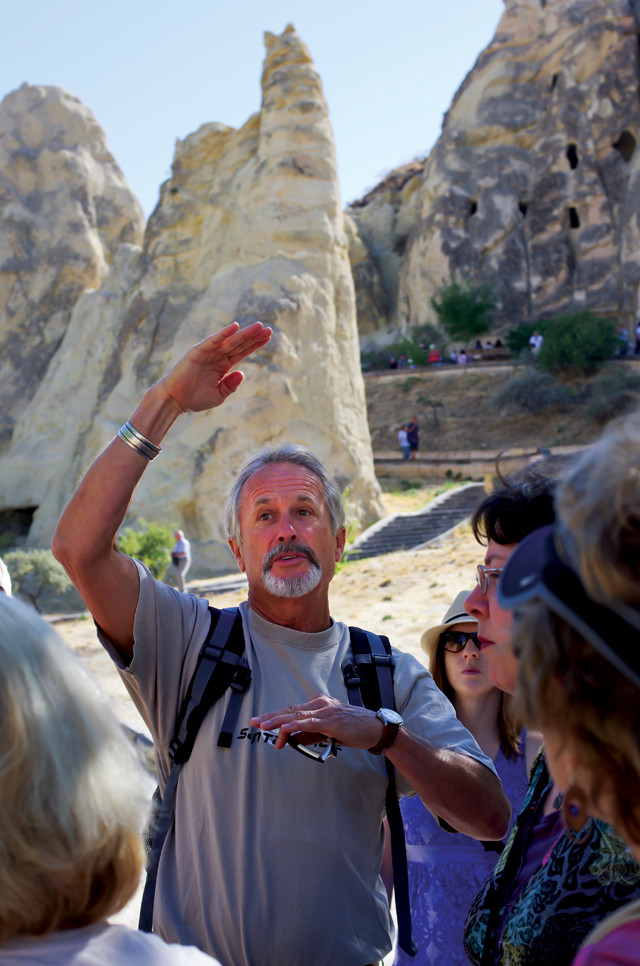
by Sarah Derouin Thursday, November 8, 2018

Coastal scientist Gary Griggs has been teaching at the University of California, Santa Cruz, for the past 50 years. An advocate for ocean science, conservation, policy and education, he has studied coasts around the world, including the beach pictured here, Coral Beach on the Isle of Skye, Scotland. Credit: courtesy of Gary Griggs.
Maybe it was the summer camping trips with his family along the Pacific coast, or perhaps surfing off Santa Barbara, Calif., during college, but Gary Griggs always gravitated to the ocean. He turned that love into a career and has spent the last 50 years teaching about the oceans and coasts at the University of California, Santa Cruz (UCSC).
It’s the kind of career that has a multigenerational impact. More than a few students have told him that their parents took his class, but he had a surprise recently. “Last year, for the first time, a student said, ‘You know, my grandmother took your class.'”
His career started with an undergraduate degree in geological sciences from the University of California, Santa Barbara (UCSB). He went on to get his doctorate in oceanography from Oregon State University where he also minored in civil engineering. Although he considers himself a coastal scientist, his doctoral research took him offshore to investigate turbidites in a deep-sea channel off the mouth of the Columbia River, which recorded the history of large Cascadia Subduction Zone earthquakes.
For 26 of his years at UCSC, Griggs also directed the Institute of Marine Sciences, a position from which he recently stepped down after having helped expand the campus’ Long Marine Laboratory to a Coastal Science Campus with university research and education programs as well as federal and state marine research facilities. In March, he was awarded the Global Oceans Award by the Seymour Marine Discovery Center in Santa Cruz for his work in ocean science, conservation, policy and education. At a banquet marking the occasion, he was introduced by his former student Kathryn Sullivan, who became a space shuttle astronaut and also headed NOAA from March 2014 to January 2017. “She’s my hero,” Griggs says.
A regular contributor to the local newspaper, the Santa Cruz Sentinel, Griggs also has authored 11 books on coastal issues, including his latest, “Coasts in Crisis: A Global Challenge,” which was published in 2017. It’s rare to have more than a couple of weeks pass without Griggs doing some sort of public outreach: speaking to community groups, hosting talks at the Seymour Center or addressing legislators or state agency groups.
Recently, Griggs spoke with EARTH about doing oceanography before plate tectonics was understood, how coastal science is becoming more relevant with rising seas, and how perceptions of the value of scientific communication and outreach have changed over the years.

Griggs is an active science communicator in the Monterey Bay area. On this field trip to Point Lobos State Reserve on the California coast, he explains the geology of California to a group of local citizens. Credit: courtesy of Gary Griggs.
SD: Have you always been interested in coasts?__
GG: My interest started early: My dad was a high school teacher, so every summer when I was a kid, we would take off on a month-long camping trip up the coasts of California, Oregon and Washington. We spent a lot of time in state parks being outside and in nature. I knew my career was going to be outside.
I think there were several things that interested me about coasts: one was surfing. Also, when I was an undergraduate at UCSB, which is right on the coast, I spent a lot of time walking along the beaches, looking at the cliffs — I loved it. I changed my major five times as an undergraduate and eventually ended up with geology.
SD: Can you tell me more about your doctoral research, which involved coring deep-sea__ sediments?__
GG: It was pretty exciting work. We were in the North Pacific in 3,000 to 4,000 meters of water taking 3- to 12-meter-long sediment cores. When you’re at sea, you don’t know what’s in the cores until you come back to the lab.
What came out of these cores were these very rhythmic turbidites, which we could track back up to the Columbia River or other sources. We did carbon-14 dating and recognized ash deposits from Mount Mazama [the collapse of which formed Oregon’s Crater Lake], and we determined that these turbidity currents had occurred every 250 to 500 years, but we didn’t know what had triggered them.
This was in the mid-1960s, before plate tectonics or knowledge of the Cascadia Subduction Zone. I asked colleagues in geophysics if they could think of any good reasons why we should have big earthquakes off the coast of Oregon. They looked at each other and said, “Not that we can think of.” So in my thesis, and then in the publication that came out in 1969, I said, “Well, maybe big storms or large earthquakes are triggering these turbidity currents.”

Griggs taught many students who went on to pursue science careers, including Kathryn Sullivan, a space shuttle astronaut and a former administrator of NOAA. Credit: courtesy of Gary Griggs.
SD: How did you switch from studying deep-sea sediments to studying coastal__ hazards?__
GG: When I came here [to UCSC], we didn’t have a ship, so I got into geologic hazards. Some people joke that most college professors spend the rest of their life rewriting their doctoral dissertation, which may not be too far from the truth in some cases — you know more about it than anybody else. However, I decided that I wasn’t wedded to that [area of study] and my work has since gone into much more applied areas, in part because of my background in oceanography, geology and civil engineering, and in part because of what is happening on coasts today. There’s more and more interest in what’s going on with coastal cities regarding development, sea-level rise and coastal retreat.
SD: Coastal hazards seem to be getting the public’s attention as a very dangerous issue. What has__ changed?__
GG: I think the issue of climate change is finally moving from the seminar room and scientific meetings to the public arena, and I feel part of the reason for that has been the series of recent, large coastal disasters, including Katrina, Sandy, the Tohoku, Japan, earthquake and tsunami, and the Indonesian-Sumatra earthquake and tsunami. And that’s what “Coasts in Crisis” is about — a number of diverse coastal issues that have now reached the surface and the front pages of the papers.
In terms of sea level itself, California has become more aware of the issue because of king tides — which are twice-yearly extreme high tides that occur when the moon is a little closer to Earth and Earth is a little closer to the sun, so gravitational attraction is greatest. All of a sudden, waves are washing up on the sidewalk along the Embarcadero in San Francisco. So people are saying maybe there’s something to this. Even the military has put out reports on the effects of sea-level rise on their bases and airfields. All these things are right on the coast, and I think the public is now becoming aware of these issues.
SD: What have you seen in the last__ 10 years__ that has changed the way that you look at coastal__ hazards?__
GG: More and more people are migrating to coastal regions — and most of the world’s megacities are on the coast. There are about 150 million people around the world living within a meter of high tide. And if we look at people who live in coastal regions broadly, there are probably 2 billion.
Even though the Fukushima event was a nuclear power plant disaster, it was caused by the Tohoku earthquake and resultant tsunami inundating the coast. We also had Katrina and Sandy, and we keep having these El Niño events. With these hazards, plus the gradual rise of sea levels, I became more aware that there are an increasing number of people exposed to these hazards who weren’t exposed a century ago.
These huge populations concentrated along the coasts also have other impacts. Where does their wastewater go? Where do they get their protein from — the ocean? What about power plants and ports and oil tankers? My background in oceanography and geology and civil engineering all came together in the coastal zone; a lot of my work has been on sea-level rise, coastal impacts and how we are, or are not, responding.
SD: You do a lot of public science outreach. Why is that important to__ you?__
GG: I think the fundamental issue is that the best policy is based on good science. What’s interesting is, when I first came to UCSC — and I would say up until maybe the last 20 years — applied science and communicating science to the public were seen as soft science, that is, not “real” science. But that never really discouraged me.
I feel just the opposite: You can be a good scientist, you can be a good teacher, and you can still contribute important things to society and policy formation.

Although coastal science is his passion, Griggs loves all things outdoors. Here in the Cappadocia region of Turkey, he explains the origins of the fairy towers (shown behind him) eroded from volcanic ash deposits. Credit: courtesy of Gary Griggs.
SD: A lot of your writing focuses on the Monterey Bay area. Why is Monterey Bay so special to__ you?__
GG: I think the [National Marine] Sanctuary makes it special. The submarine canyon — one of the deepest canyons in the world — makes it special, as does the diversity of marine life, even though that’s not what I study firsthand. We’ve got whales and dolphins and sea otters and a diversity of marine birds. But I think it’s the whole sense of place that matters and makes this coast special to me.
Because there’s so much diversity between the ocean, the coastline and the Santa Cruz Mountains, we probably have more geologic hazards per square mile than any other county in the state, including coastal erosion, cities on flood plains, and hillsides with landslides and debris flows. And then at the inland edge of the county, we have the mother of them all, the San Andreas Fault.
A lot of the natural world is represented here, and it’s where I’ve spent 50 years of my life — I just find it a really exciting and interesting place to study and teach. There’s still a lot to understand, and also a unique environment that is important to preserve.
© 2008-2021. All rights reserved. Any copying, redistribution or retransmission of any of the contents of this service without the expressed written permission of the American Geosciences Institute is expressly prohibited. Click here for all copyright requests.